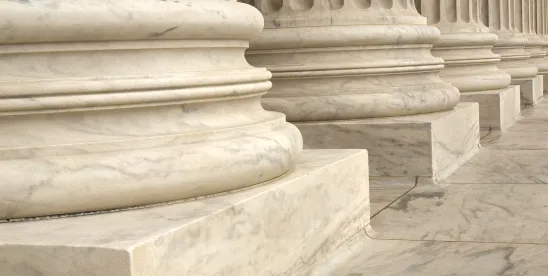Given the continuing discussion about the Supreme Court’s decision to overrule Chevron in Loper Bright Enterprises v. Raimondo, we thought that a review of the decision (and its limits) is in order.
The Loper Bright decision
The 6-3 decision written by Chief Justice Roberts launched a full-throated attack on deference to administrative agencies: “Chevron gravely erred”; it “required judges to disregard their statutory duties”; it is “fundamentally misguided,” “impressionistic and malleable.” The Court concluded: “Courts must exercise their independent judgment in deciding whether an agency has acted within its statutory authority.”
Starting with first principles, the Court explained that the judiciary interprets the law. That tradition persisted through the New Deal, the Court recounted, when decisions like Skidmore v. Swift & Co. permitted agency deference based only on the “power to persuade.” The Court framed Chevron v. NRDC as a departure from that tradition by sometimes insisting on deference to agency interpretations. When a statute is “silent or ambiguous,” Chevron required courts “to defer to the agency if it had offered ‘a permissible construction of the statute.’” The majority criticized that rule as unworkable, as shown by subsequent efforts to clarify the standard (like US v. Mead Corp’s “step-zero” analysis) that “only added to Chevron’s unworkability, transforming the original two-step into a dizzying breakdance.”
In addition to those structural concerns, the Court relied on the Administrative Procedure Act, whose Section 706 instructs courts to “decide all relevant questions of law, interpret constitutional and statutory provisions, and determine the meaning or applicability of the terms of an agency action.” By contrast, the APA “does mandate that judicial review of agency policymaking and factfinding be deferential.” The majority read the APA, like the constitution, to require courts to exercise “independent judgment on questions of law.” The majority also rejected the dissent’s stare decisis concerns, stating that “[r]ather than safeguarding reliance interests, Chevron affirmatively destroys them.”
Justice Thomas and Justice Gorsuch separately concurred, the former focusing on separation of powers concerns and the latter addressing stare decisis concerns. Justice Gorsuch offered: “judges [play] a lawfinding rather than lawmaking role” that at times requires courts to “inter” bad precedents. In dissent, Justice Kagan returned to her common theme of adherence to precedent, and she also defended Chevron deference as correct in the first instance.
The limits of Loper Bright
Despite overruling Chevron, the majority was clear that substantive holdings using the deference framework remain good law. Loper Bright, after all, only affects agency rules or action that is based on statutory ambiguity or silence. As under Skidmore, we can expect courts to continue to adopt agency rules and interpretations that are persuasive or backed up by significant experience. Substantive holdings that Chevron produced are subject to their own stare decisis analysis, which applies with strongest force in statutory interpretation cases—as the Court itself recognized.
In addition, deference to an agency’s interpretation of its own regulations (“Auer deference”) ostensibly remains good law; after all, the Court favorably cited Kisor v. Wilkiea handful of times.
There are other limits, including that Loper Bright only applies to an agency’s conclusions of law; it does not affect the traditional deference to agency factfinding. The APA states that such findings of fact can be set aside only if they are “unsupported by substantial evidence.” And nothing in Loper Bright prevents courts from interpreting statutes to recognize that Congress has delegated an agency wide discretion: “When the best reading of a statute is that it delegates discretionary authority to an agency, the role of the reviewing court under the APA is, as always, to independently interpret the statute and effectuate the will of Congress subject to constitutional limits.”
Ultimately, the effects of Loper Bright will likely be on full display in fields subject to new or evolving regulation, as they will be more vulnerable to challenge without Chevron deference.
The long decline of Chevron
An interesting subplot to Chevron’s fall is that it has been coming for a long time–hopefully facilitating a smooth transition to the new standard. The Court hadn’t “deferred to an agency interpretation under Chevron since 2016,” in Cuozzo Speed Technologies v. Lee. To the dissent, this was a purposeful preparation “to overrule Chevron.” The Court passed over many chances to defer, such as in cases like West Virginia v. EPA that present “major questions” of “deep … significance.” Part of the dynamic, as the Court explained it, is that where “[o]ne judge might see ambiguity everywhere; another might never encounter it.” The Court cited Judge Kethledge for the second proposition. Judge Kethledge said in a 2017 article: “I personally have never had occasion to reach Chevron’s step two in any of my cases.”
But not every Sixth Circuit judge can say the same. In Valent v. Commissioner of Social Security, for example, the court finding the relevant statute ambiguous deferred to the Commissioner’s reasonable interpretation. This prompted Judge Kethledge to dissent. In a more recent case, Ohio v. Becerra, the Sixth Circuit applied Chevron because Supreme Court precedent interpreting the same statute compelled deference. But the court observed a shifting “doctrinal landscape” that left “[t]he status of the Chevron deference doctrine … notoriously uncertain.” (In Becerra, Chevron helped sustain part of an abortion-related HHS rule).
Reflecting the shift in administrative law, our review of Sixth Circuit cases shows that the court of appeals has been citing Chevron less and less – and for less-important reasons – over the past fifteen years. For example, last year in Hardin v. ATF, the Sixth Circuit resorted to the rule of lenity instead of Chevron deference to resolve an ambiguity in favor of the private citizen by deciding that a semi-automatic gun equipped with a bump stock is not a machine gun—the same ruling the Supreme Court recently reached in Garland v. Cargill. As the Sixth Circuit maintains an active administrative law docket, its cases ushering in the Loper Bright era will be critically important.





 />i
/>i

